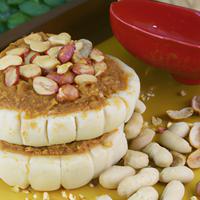
1 serving (100 grams) contains 200 calories, 5.0 grams of protein, 5.0 grams of fat, and 40.0 grams of carbohydrates.

Log this food in SnapCalorie

Nutrition Information
Calories |
476.2 | ||
|---|---|---|---|
% Daily Value* |
|||
| Total Fat | 11.9 g | 15% | |
| Saturated Fat | 2.4 g | 12% | |
| Polyunsaturated Fat | 0 g | ||
| Cholesterol | 0 mg | 0% | |
| Sodium | 357.1 mg | 15% | |
| Total Carbohydrates | 95.2 g | 34% | |
| Dietary Fiber | 4.8 g | 17% | |
| Sugars | 35.7 g | ||
| protein | 11.9 g | 23% | |
| Vitamin D | 0 mcg | 0% | |
| Calcium | 47.6 mg | 3% | |
| Iron | 2.4 mg | 13% | |
| Potassium | 238.1 mg | 5% | |
* Percent Daily Values are based on a 2,000 calorie diet. Your daily values may be higher or lower depending on your calorie needs.
Food Attributes
Source of Calories
About Peanut ang ku kueh
Peanut Ang Ku Kueh is a traditional Chinese pastry originating from Fujian, China, and is also popular in Southeast Asia, particularly Singapore and Malaysia. This sticky rice snack is characterized by its vibrant red hue, symbolizing joy and prosperity, and its soft, chewy texture. Made from glutinous rice flour and sweet peanut filling, it is shaped like a tortoise shell and steamed to perfection. The peanut filling adds protein and healthy fats, while the glutinous rice flour contributes quick energy through carbohydrates. While it is cholesterol-free and low in saturated fats, its high sugar content and refined carbs make it less ideal for health-conscious individuals or diabetics. Nonetheless, Peanut Ang Ku Kueh is a cultural treat often enjoyed during festive occasions and celebrations, valued for its auspicious symbolism and comforting flavors.



